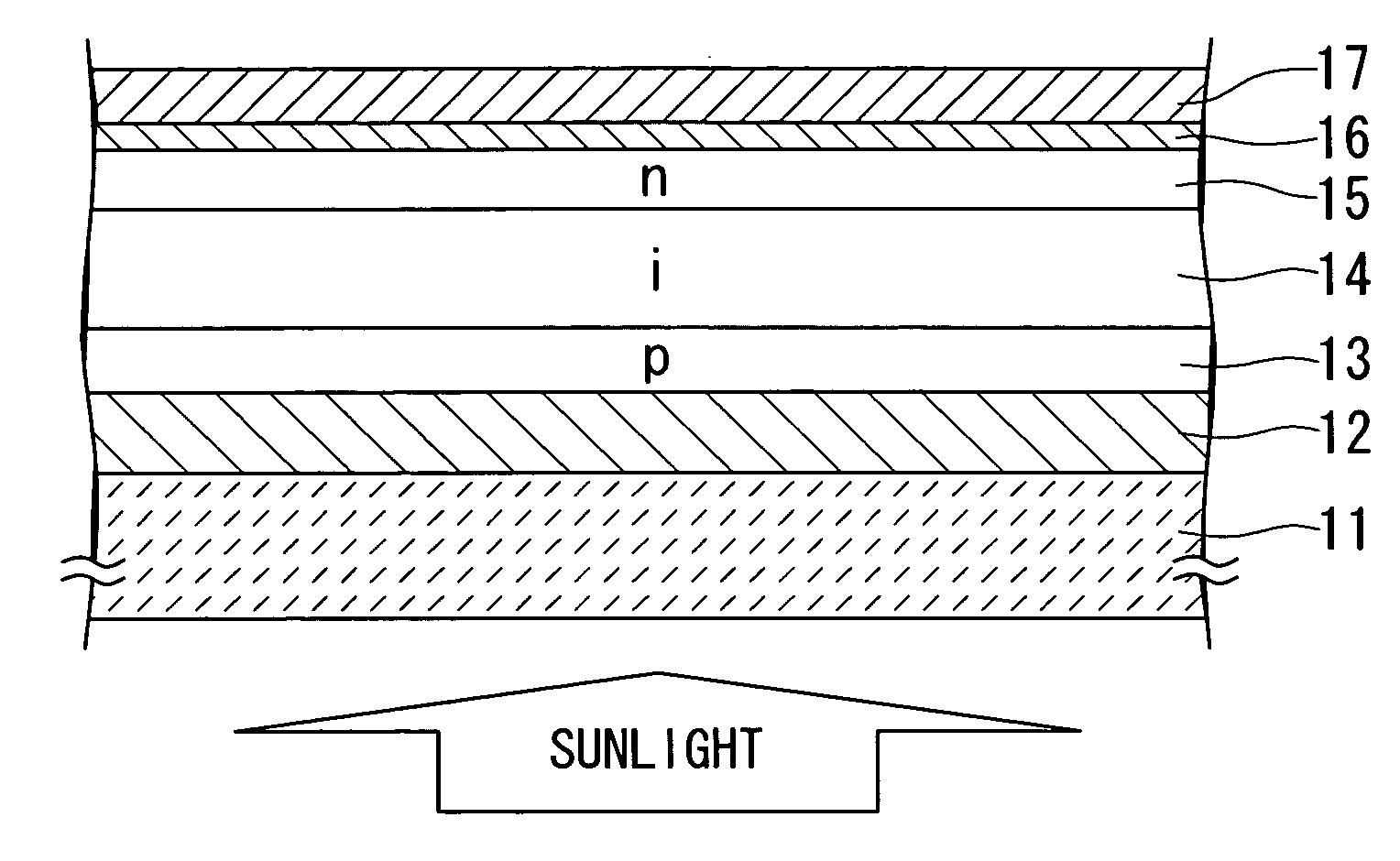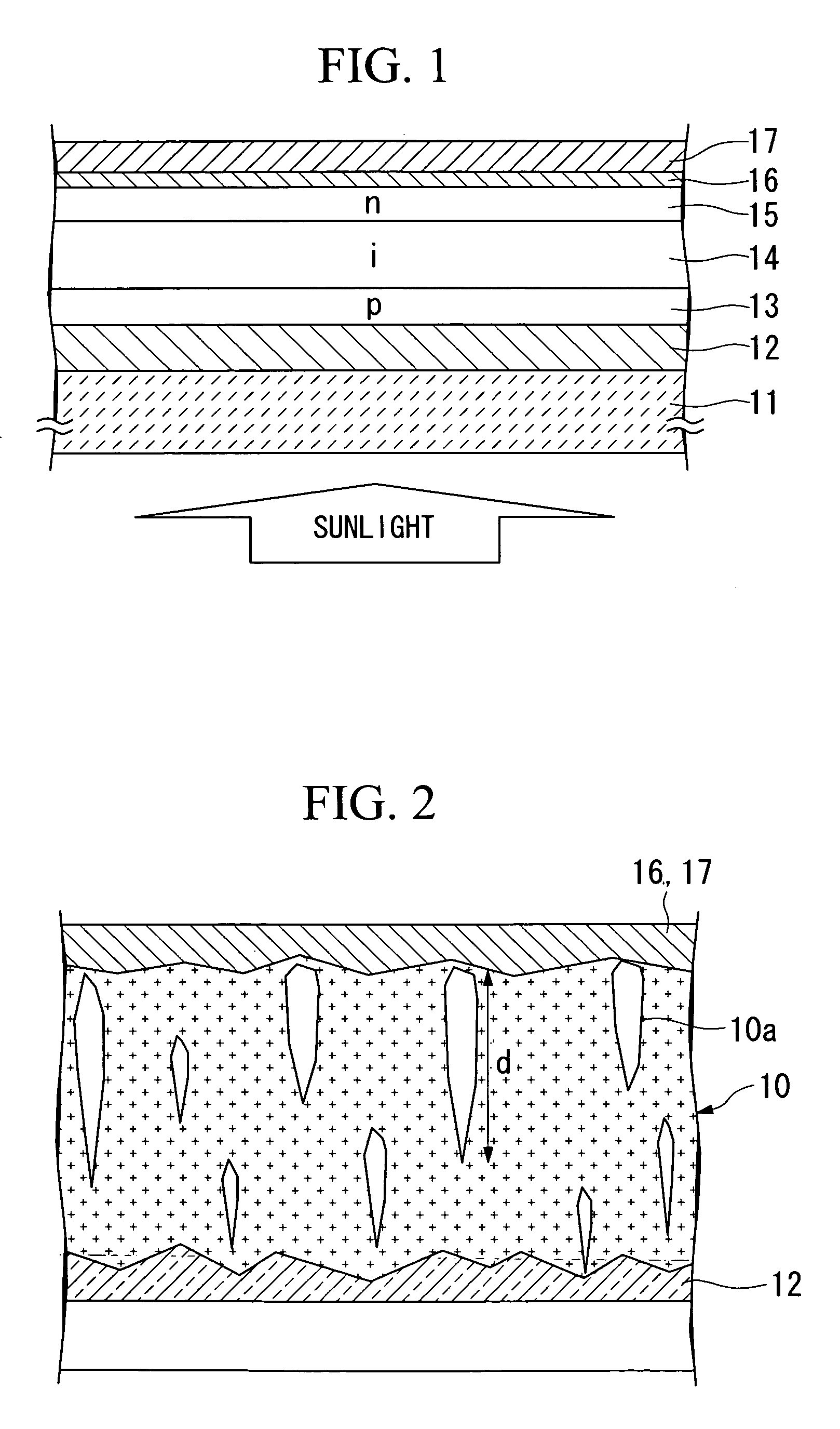Solar cell and process for producing solar cell
a technology of solar cells and solar cells, applied in the field of solar cells and processes for producing solar cells, can solve the problems of low conversion efficiency, increase in the number, and obstacles to overcome, so as to improve the photovoltaic conversion efficiency, avoid recombination, and reduce grain boundaries
- Summary
- Abstract
- Description
- Claims
- Application Information
AI Technical Summary
Benefits of technology
Problems solved by technology
Method used
Image
Examples
first embodiment
[0064] A process according to the present invention for producing the type of solar cell into which light enters through the electrically insulating substrate side will be described with reference to FIG. 1.
First Step
[0065] A first transparent electrode (first electrode) 12 is formed on an electrically insulating transparent substrate (electrically insulating substrate) 11. Optically transparent white crown glass, for example, can be used for the electrically insulating transparent substrate 11. The first transparent electrode 12 is made of a metal oxide such as tin oxide (SnO2) or zinc oxide (ZnO). In order to prevent the first transparent electrode 12 from being reduced by hydrogen used in the production step of polycrystalline silicon layers as explained below, a zinc oxide film with a thickness of several tens of nanometers may be formed on the first transparent electrode 12.
Second Step
[0066] Subsequently, while the electrically insulating transparent substrate 11 on which...
second embodiment
[0082] Next, a process for producing a solar cell will be described as a second embodiment of the present invention. The process for producing a solar cell according to the second embodiment differs from that according to the first embodiment explained above in that thermal annealing of the p-type or n-type silicon layer after formation of the first transparent electrode is carried out in a low-pressure oxygen atmosphere. Therefore, the step of thermal annealing in oxidation atmosphere of the p-type or n-type silicon layer will be described in detail for the second embodiment, whereas detailed description of the other steps, which are similar to those in the first embodiment, will be omitted.
[0083] In the first step, a first transparent electrode (first electrode) is formed on an electrically insulating transparent substrate (electrically insulating substrate). Then, in the second step, a polycrystalline p-type silicon layer is formed on the first transparent electrode using a plas...
third embodiment
[0097] A process according to the present invention for producing the type of solar cell into which light enters through the second transparent electrode side will be described with reference to FIG. 16.
First Step
[0098] A back electrode 18 made, for example, of Al or Ag is formed on a electrically insulating transparent substrate 11 (electrically insulating substrate) made, for example, of optically transparent white crown glass. Then, a first transparent electrode 19 made of a metal oxide such as zinc oxide (ZnO) or indium tin oxide (ITO) is formed on the back electrode 18.
Second Step
[0099] Subsequently, while the electrically insulating transparent substrate 11 on which the first transparent electrode 19 is formed is held as a processing object on an anode of a plasma enhanced CVD apparatus, the processing object is housed in a reaction chamber, which is then evacuated to a vacuum using a vacuum pump. Then, electricity to a heater incorporated in the anode is turned on, and ...
PUM
| Property | Measurement | Unit |
|---|---|---|
| temperature | aaaaa | aaaaa |
| temperature | aaaaa | aaaaa |
| temperature | aaaaa | aaaaa |
Abstract
Description
Claims
Application Information
 Login to View More
Login to View More - R&D
- Intellectual Property
- Life Sciences
- Materials
- Tech Scout
- Unparalleled Data Quality
- Higher Quality Content
- 60% Fewer Hallucinations
Browse by: Latest US Patents, China's latest patents, Technical Efficacy Thesaurus, Application Domain, Technology Topic, Popular Technical Reports.
© 2025 PatSnap. All rights reserved.Legal|Privacy policy|Modern Slavery Act Transparency Statement|Sitemap|About US| Contact US: help@patsnap.com



